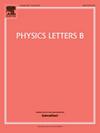Discovering an invisible Z′ at the muon collider
IF 4.3
2区 物理与天体物理
Q1 ASTRONOMY & ASTROPHYSICS
引用次数: 0
Abstract
We show in this letter how a heavy invisible gauge boson that will practically be out of reach of the Large Hadron Collider (LHC), can be discovered at the future muon collider. The new force carrier has a relatively stronger coupling with the beyond standard model (BSM) sector, while its interaction with the SM fields is much weaker. This weaker coupling is induced through mixing mechanisms, specifically via gauge kinetic mixing and the mixing. We consider a scenario where the new gauge boson decays mostly to charge-neutral long-lived particles and/or dark matter (DM). We show how producing and detecting this heavier invisible , that will be beyond the reach of even the very high luminosity LHC, becomes possible if it is produced in association with an energetic photon at the future muon collider. The on-shell production of the will lead to a peak in the photon energy distribution, following the so-called radiative return phenomena and can lead to the accurate determination of the mass and its interaction with SM particles.
在介子对撞机上发现一个看不见的Z '
我们在这封信中展示了一种重的(O(TeV))不可见的Z规玻色子是如何在未来的μ子对撞机上发现的,这种玻色子实际上是大型强子对撞机(LHC)无法探测到的。新型力载体与超标准模型扇区的耦合较强,而与超标准模型场的相互作用较弱。这种弱耦合是通过混合机制引起的,特别是通过规范动力学混合和Z - Z '混合。我们考虑了一种新的规范玻色子主要衰变为带电的长寿命粒子和/或暗物质(DM)的情况。我们展示了如何产生和探测这种更重的不可见的Z ',即使是非常高亮度的大型强子对撞机也无法达到,如果它与未来的介子对撞机的高能光子相关联,它将成为可能。在壳层上产生的Z′将导致光子能量分布的峰值,遵循所谓的辐射返回现象,并可以精确测定Z′的质量及其与SM粒子的相互作用。
本文章由计算机程序翻译,如有差异,请以英文原文为准。
求助全文
约1分钟内获得全文
求助全文
来源期刊

Physics Letters B
物理-物理:综合
CiteScore
9.10
自引率
6.80%
发文量
647
审稿时长
3 months
期刊介绍:
Physics Letters B ensures the rapid publication of important new results in particle physics, nuclear physics and cosmology. Specialized editors are responsible for contributions in experimental nuclear physics, theoretical nuclear physics, experimental high-energy physics, theoretical high-energy physics, and astrophysics.
 求助内容:
求助内容: 应助结果提醒方式:
应助结果提醒方式:


